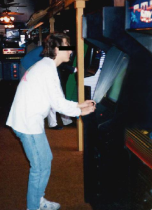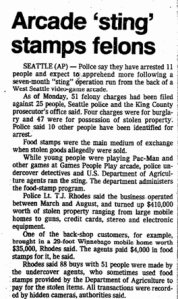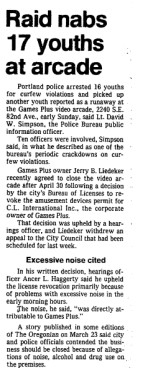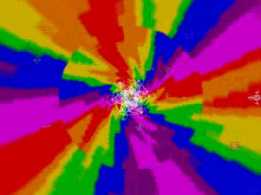(Originally published in Retrocade Magazine 2012 by Catherine DeSpira)
To someone passing by the site of the former Malibu Grand Prix Arcade (MGP), in Beaverton, Oregon, one would not think that the miniature racing track was once the birthplace of what has become one of the most persistent urban legends in arcade gaming history.
 Driving up to the Malibu Grand Prix (now Malibu Raceway) on a cold and rainy November day, I pulled right up to the front door of the low slung, red and white rectangular building and realized I probably should have called first. Closed.
Driving up to the Malibu Grand Prix (now Malibu Raceway) on a cold and rainy November day, I pulled right up to the front door of the low slung, red and white rectangular building and realized I probably should have called first. Closed.
During the warmer months of the year the place is teeming with people, each parent’s young son or daughter anxious to grip the fast feel of driving a miniature race car. But today the wind rises up hard from the Pacific, the rain cutting sideways, and I cannot imagine anyone wanting to face this weather for even the most remote of thrills. Peering through the glass door I see the arcade is still there, but the whir and flashing lights of the classic arcades have been replaced with soulless “redemption games”, the new money maker of a brand new era.
But The 80s feel is still there, bittersweet, still palpable and touchingly reachable by those who can remember when Arcade was king. For a moment I stand there, hands cupped against the glass, peering in the door, a ripple of longing clasping hands with a memory. I remember walking in this very door back in the summer of 1983 and being swept up in the sudden excitement of lights blinking from ranks of new video games calling out electronic responses like a choir practice of robots. I remember the world awash with light, excitement so on the edge you could feel the pulse of it coming off of people’s bodies. I had an instant first crush on a cute boy playing Donkey Kong and felt the earth shift on its axis when he asked me if I wanted to play with him. Some things time just can’t wash away.
So it’s still hard for me to accept that my investigative research told me this was the place where it all began, the place where two simple and not that unusual events occurred in 1981 only to be met with coincidental and unrelated ones that grew into legend. Harder still is that 30 years have passed since the events occurred, traveling through the decades to land in the present just as confusing as they ever were. The kids of that arcade are now, like me, middle-aged adults. Many of the small details of that time of ‘who, what and where’ have been forgotten, misplaced or are completely irretrievable.
But something did happen in the Fall of 1981, first at the Malibu Grand Prix Raceway’s arcade (now the site of CarMax), and then at subsequent others. Had those kids been adults, regular consumers of local newspapers and the 10 o’clock news, the legend of Polybius might not have been formed. But because the most impressionable eye witnesses were kids, unfamiliar with more sophisticated methods of communicating fact, the only avenue of resource they had was talking to other kids, which helped grow the initial story into something straight out of science fiction.
The Original Internet Legend Circa 1994
 As with all urban legends, depending on how long they have been circulating, once the groundwork is laid by the initial event, decade by decade more layers are added. Just like the amusing act of whispering something in one person’s ear, then passing the message down to another and so forth and so forth; what comes out at the end is usually very different from how it started. Such is the story of Polybius, a multi decade exercise in how legends begin and how they changed in passing.
As with all urban legends, depending on how long they have been circulating, once the groundwork is laid by the initial event, decade by decade more layers are added. Just like the amusing act of whispering something in one person’s ear, then passing the message down to another and so forth and so forth; what comes out at the end is usually very different from how it started. Such is the story of Polybius, a multi decade exercise in how legends begin and how they changed in passing.
According to the earliest Internet form of the legend, found in the archives of Usenet, a new game appeared in several suburbs of Portland, Oregon, in November, 1981. The Tempest-like game, reportedly called Polybius, allegedly created by the covert German company, Sinnesloschen, was an instant hit and popular with some players to the point of addiction. Eye witnesses claim Polybius was in a plain, black and unmarked cabinet (such as this unidentified player, on an unidentified game, playing in a photo supposedly taken at an arcade, in Oregon, 1984. The photo is a fake). 
Players, and exclusively young adult males and teens, gathered around the game, forming lines, with brawls often breaking out over who got to play next. Many of the more obsessive players suffered various side effects from playing the game, most notably memory loss, nightmares, paranoia, insomnia and catatonia with flashing images of words and phrases in their minds. Some players quit the game completely, with one purportedly becoming an anti-video game activist in a crusade against them.
Apparently the game’s program incorporated rapidly revolving kaleidoscopic puzzles, interconnected with numeric shapes and subliminal messages that deeply affected the consciousness of some players. We do not know. No roms have ever been recovered from the mysterious game. But one could generalize that the same theory applied in the creation of The Dream Machine by Ian Sommerville in 1961, a stroboscope believed to alter the brain’s alpha waves and produce trance-like levels of relaxation when used for extended periods of time, could have been used in another, more modern platform game. But unlike The Dream Machine, Polybius’ rotating lights and colors were thought to have been designed for a very different purpose, that being for “mind control”.
Legend tells us that players felt as if they were no longer in control of their thoughts after playing the game, that they were still being prompted to think negative thoughts, many of them feeling they were of danger to themselves. One suicide is rumored and, depending on which version of the legend one hears – murder as well. No doubt someone got their facts confused with the unrelated 1983 mass murder in a Texas arcade which, curiously enough, occurred at a Malibu Grand Prix arcade as well.
Weeks after the alleged events in 1981 in Portland, Oregon, as the legend goes, Men in Black, the harbingers of Government activity, began to show up to collect some form of unknown data from the machines, allegedly testing responses to the supposedly psychotomimetic game. It was reported that sometimes the men in black could be seen going to the cabinets, inspecting them, sometimes taking out unknown parts and quietly walking away. Often times they loaded them up in trucks and transported them elsewhere. One day, it is rumored, they took all the Polybius machines away and they were never seen again.
Quite a fantastical story. But many points are correct:
- A “Tempest-like” game did appear in Portland in November 1981 as seen in bills of sale by five former early 80s arcade operators and confirmed by the one and only distributor in the area at the time, Todd Levy, owner of Ability Games Distribution Company. The game was Tempest.
- There are two documented 1981 events of arcade players experiencing negative effects from gaming while living in the Portland area but not one of them is a seizure. Nationally there are only 9 instances of seizure activity ever reported by responding physicians in the USA between 1981-1984 from playing video games, predominately on home consoles. Only one was from a cabinet-style arcade game: Astro Fighter (1980 Gremlin/Sega)
- Government agents did seize and/or load up video games on two separate occasions in 1981 and 1982. They did take down the initials of high scorers on games as a way to determine the names of possible eye witnesses to on site crimes they were investigating.
- Government agents did inspect the backs of certain games, looking for cords that led to “counters” and other illegal apparatus used in gambling and, on occasion, removed “unknown parts” from games because of that reason.
- There was a government test on an arcade and the habits of its players as ruled by the Supreme Court, in November of 1981. But it wasn’t in The Pacific Northwest. It was in Mesquite, TX, at Aladdin’s Castle, after Atari, fearful of financial losses, legally opposed a Texas ordinance trying to take root in other States, that held that citizens under the age of 17 could not operate a coin op game. (Thank you, Atari) The test was conducted to study if video games were addictive enough to merit regulation to minors.
 Gambling on pinball goes way back and is well documented. But it’s also documented on video game card games, like, Draw 80 Poker and Blackjack, where a counter was attached to the game, and run to the back bar, to record winning hands over the allotted legal limit of 15 wins per person that would show on the game. Anything over 15 wins, and the bar owner would illegally pay you cash on your winnings, cashing in more so on failed attempts. With the advent of video game arcades for kids, the concern deepened. Watch groups sprung up overnight in cities across the US, claiming video game parlors/arcades taught children how to gamble. Between 1979 and 1982 parent watch groups had petitioning the Supreme Court numerous times, over and over again to intervene, citing video game parlors as a detriment to good old fashioned American morality.
Gambling on pinball goes way back and is well documented. But it’s also documented on video game card games, like, Draw 80 Poker and Blackjack, where a counter was attached to the game, and run to the back bar, to record winning hands over the allotted legal limit of 15 wins per person that would show on the game. Anything over 15 wins, and the bar owner would illegally pay you cash on your winnings, cashing in more so on failed attempts. With the advent of video game arcades for kids, the concern deepened. Watch groups sprung up overnight in cities across the US, claiming video game parlors/arcades taught children how to gamble. Between 1979 and 1982 parent watch groups had petitioning the Supreme Court numerous times, over and over again to intervene, citing video game parlors as a detriment to good old fashioned American morality.
To me, it’s no surprise to see how all of these facts got misconstrued into an urban legend surrounding a game that, for all respects, did not exist. I believe it didn’t exist as there would have been no reason for it to. By 1981 the video game industry was a booming business being threatened by a handful of moral zealots who, although small in their numbers, had the potential to cause serious harm to the gaming industry during the Cold War conservatism of Reagan Era America. With arcade games already under intense scrutiny by The Supreme Court, no one in their right mind would have made a game like Polybius, or even wanted to. The last thing on any game developer’s mind was to create a game that caused physical harm and damaged profits.
I’m actually surprised the legend doesn’t claim the Russian government made Polybius. That would have made more sense at the time, given that a political poll from 1980 shows that 3 out 5 American voters still thought the former Soviet Union was a military threat.
Case Fact: Oregon Records of Arcade Incidents
The actual events that I believe began the Polybius legend are relatively simple.
At the Malibu Grand Prix arcade, on November, 27, 1981, beginning at 11:00 am, 12-year old, Brian Mauro, as recorded by The Oregonian newspaper, blasted away at Asteroids over the Thanksgiving Day 3-day weekend, in a bid to break the world record of 30.1 million previously set by 16-year old Dennis Hernandez of Geneva, NY.
Malibu Grand Prix arcade, on November, 27, 1981, beginning at 11:00 am, 12-year old, Brian Mauro, as recorded by The Oregonian newspaper, blasted away at Asteroids over the Thanksgiving Day 3-day weekend, in a bid to break the world record of 30.1 million previously set by 16-year old Dennis Hernandez of Geneva, NY.
Hernandez game had lasted 52 hours, 11 minutes. Mauro believed he could beat it, and so did his father, Joe, who remained at his son’s side the whole time in support. Wearing wrist braces and special gloves, and donning a tuxedo for part of his game, young Mauro gave it his all. But 28 hours into a 48 hour challenge, taking only Coca Cola and orange juice for nourishment, Mauro succumbed to painful cramps in his arms and serious gastrointestinal upset, forcing him to forfeit his attempt prematurely. His game ended on November 28, 1981. He spent two days in bed, unable to eat anything but small sips of soup, mentally drained from the ordeal. His ending score was 14 million points. Mauro was, and still remains, the youngest video game marathoner in classic arcade history.
 But he wasn’t alone in having suffered uncomfortable symptoms from going for video game glory, for on the very same day, at the very same arcade, 14-year old Michael Lopez, of Beaverton, Oregon, was challenging his friends on Atari’s Tempest, trying to beat his buddy’s personal best.
But he wasn’t alone in having suffered uncomfortable symptoms from going for video game glory, for on the very same day, at the very same arcade, 14-year old Michael Lopez, of Beaverton, Oregon, was challenging his friends on Atari’s Tempest, trying to beat his buddy’s personal best.
According to Mr. Lopez, now a night club owner in Seattle, Washington, he and his friends were battling it out at Malibu Grand Prix arcade, taking turns on the game when, right in the middle of his game, he began to feel strangely.
“I began to feel a weird sensation in the back of my head, then my vision started going out. Little flashing lights. Suddenly I got sick and stumbled outside where I threw up all over the parking lot. One of my friends walked with me back home, but we didn’t make it all the way there. My head hurt so bad. It got to where I couldn’t speak. I couldn’t walk any more. I collapsed on someone’s lawn, four blocks from my house, rolling and screaming in pain. It felt like my head was cracking open. Someone called the cops. That was the first migraine headache I ever had. I’ve had them off and on my whole life since. But it was freaky because I didn’t know what was happening at the time.”
As a migraine sufferer myself, my first one occurring at age 15, I admit I find the visual pace and subtle flash of Atari’s Tempest uncomfortable. Star Wars, too. Any intense visual stimuli coupled with flash in a game will trigger a migraine in me which is why I don’t play many early Atari “space shooters”. My brain can’t handle that kind of rapid eye movement. But it’s not the game’s fault that my basal ganglia have some faulty parts in its complex harness of neurological wiring. Blame that on genetics.
Days later, at school, other kids were already talking about Lopez’ “freak out”, distorting facts, and adding their own. One rumor was that the game had tried to take over his mind, and when he fought against it, it fought back. Lopez told them that it was just a migraine and tried to explain it to his friends. But that didn’t stop the kids from talking and making their own assumptions about a common neurological disorder they didn’t understand.
“My friends were totally weirded out, “Lopez recalls. “They were convinced the game had damaged me. When I got back to school people were talking about how the game was dangerous. I told them, ‘Naw…it was a migraine’. But they figured since I’d been perfectly fine up until that point that it had to be the game. And every time I got one after that, they would say, ‘Man, that game messed you up.’ There were kids at school, who after hearing about what happened to me, would not play it. They’d play every other game but that one. They actually thought it would damage your brain. But then there were the guys who now wanted to play it. It became like a challenge or something. But it was hard to find after that. It just kind of disappeared for a while. I always thought that was weird.”
Although no police record remains of Lopez’ incident, due to Oregon State regulations that all Police record reports be shredded after 20 years, the dispatch call record on this incident has survived and has been preserved on microfilm.
Enter the Men In Black
 Ten days later, news flashed around the State that local police and a bevy of Federal Agents (Men in Black), stormed several bars, lodges and arcades in the Beaverton and Portland area in a “Video Game Raid”. According to The Oregonian, on December, 9, 1981, after a year of surveillance a warrant was issued to a 48-year old arcade operator, who later admitted he was rigging his games up for gambling. By wiring the games with a “counter” to record how many games a player had accumulated for play, the arcade owner was illegally paying out money instead of points.
Ten days later, news flashed around the State that local police and a bevy of Federal Agents (Men in Black), stormed several bars, lodges and arcades in the Beaverton and Portland area in a “Video Game Raid”. According to The Oregonian, on December, 9, 1981, after a year of surveillance a warrant was issued to a 48-year old arcade operator, who later admitted he was rigging his games up for gambling. By wiring the games with a “counter” to record how many games a player had accumulated for play, the arcade owner was illegally paying out money instead of points.
Months later, in Seattle, Washington, The Oregonian reported in 1982 that, while kids gathered around Pac-Man and other games, the Games People Play arcade, a sting operation set up and run by undercover Federal Agents, arrested 25 suspects for the intent to sell stolen property on site. During a seven-month sting operation, one that yielded over $400,000 (1.1M today) in the retrieval of stolen goods, the agents ran a very convincing fake arcade. Repeat: Games People Play Arcade, Seattle, Washington, is documented in 1982 as having been used for a Federal sting operation.
 Prior to set up and to preserve secrecy, agents had purchased games from Portland arcade operators, wired them with cameras and microphones, and set them up in an arcade in West Seattle. Certain games were favored by agents as being more likely to entice their subjects into staying a while after selling stolen goods. No doubt the agents believed that during the game suspects might unknowingly make incriminating statements while they played with their friends, unaware they were being filmed and recorded. A popular and difficult game to get at the time due to cost and supply was Tempest, number one on the Fed’s game list, along with Scramble and Galaxian. This meant that suddenly quite a few Portland operators were Tempest-less as there were only 3 in the entire Portland-Metropolitan area at the time.
Prior to set up and to preserve secrecy, agents had purchased games from Portland arcade operators, wired them with cameras and microphones, and set them up in an arcade in West Seattle. Certain games were favored by agents as being more likely to entice their subjects into staying a while after selling stolen goods. No doubt the agents believed that during the game suspects might unknowingly make incriminating statements while they played with their friends, unaware they were being filmed and recorded. A popular and difficult game to get at the time due to cost and supply was Tempest, number one on the Fed’s game list, along with Scramble and Galaxian. This meant that suddenly quite a few Portland operators were Tempest-less as there were only 3 in the entire Portland-Metropolitan area at the time.
The reason only certain game titles made the Fed’s game list was because the smoked glass bezel on them was ideal for hiding a camera inside.
 According to area operators, the presence of Federal Agents in the arcades prior to the sting purchase was not unusual. Many report that unannounced walk thrus were not uncommon and that local police also made even more frequent walk thrus, checking for truancy and other suspicious behavior. Arcades were seen by many parents as the devil’s playground for delinquency and drugs. Law enforcement agreed. They were also, as indicated in numerous reports, places were illegal gambling and fencing of stolen goods thrived. In Portland alone, in 1981, police and federal agents made 52 arrests and 7 raids for the above noted activity. I’m sure not all arcades in the Pacific Northwest were “dirty” but it appears on paper that a lot of them were.
According to area operators, the presence of Federal Agents in the arcades prior to the sting purchase was not unusual. Many report that unannounced walk thrus were not uncommon and that local police also made even more frequent walk thrus, checking for truancy and other suspicious behavior. Arcades were seen by many parents as the devil’s playground for delinquency and drugs. Law enforcement agreed. They were also, as indicated in numerous reports, places were illegal gambling and fencing of stolen goods thrived. In Portland alone, in 1981, police and federal agents made 52 arrests and 7 raids for the above noted activity. I’m sure not all arcades in the Pacific Northwest were “dirty” but it appears on paper that a lot of them were.
Coinciding with the two “video game injuries” at Malibu Grand Prix arcade, then the subsequent disappearing act of Tempest, coupled with kids hearing from their parents how arcades were being raided by Feds, kids had to have been affected in some way by it. Going on hearsay from their parents, and probably upset by the bad rap arcades were getting, kids would have passed the story on, and no doubt added to it their own opinions. I would bet that there was an increased fascination with this so called “dangerous game” and that many boys now couldn’t wait to find it and play it out of curiosity.
 But chances are they never did. By the time Tempest might have made its way back into the area arcades in late 1982 most of the arcades in Oregon were closed or closing and the new consoles now reigned supreme. That’s a lot of kids in Portland who never got to play Tempest in an arcade, or only got a single glimpse of it before it vanished, its name forgotten until…
But chances are they never did. By the time Tempest might have made its way back into the area arcades in late 1982 most of the arcades in Oregon were closed or closing and the new consoles now reigned supreme. That’s a lot of kids in Portland who never got to play Tempest in an arcade, or only got a single glimpse of it before it vanished, its name forgotten until…
I can see one of them grown up, sitting at the computer 20 years later, reading posts on a forum on ‘Classic Games’ and finding the one about the mysterious Polybius, passed down from the original on Usenet. He would remember the time when he heard of Mauro and Lopez being “incapacitated” by a game. He would recall “the men in black”, the raids, and added them in his response to the post. As hindsight in history is often blurred by the present, chances are his recollection of events were not factual, leaving one swimming in the irony of what the real Polybius warned of in 252 BC, when he wrote:
“Careful, for when you pick up the pen you may accidentally change history thus allowing the next man in line, with unclear intent, to do the same.”
That next man was Steven Roach.
The “New and Improved” Legend 2006
 “I think it’s about time I laid this to rest…”
“I think it’s about time I laid this to rest…”
So begins self-confessed designer of 1981’s Polybius, Steven Roach, in one of the worst and most see-thru examples of internet hoaxing on the Polybius today.
He first appeared on a forum in 2006 on Coinop.org on a subject concerning the Polybius Myth, setting off a landslide of new interest in the legend.
Abounding with run on sentences and various misspellings it hardly appears to be written by a man capable of creating a ground breaking program. The post is highly suspicious, for not only does it teem with inconsistencies in the manners of business protocol found in early program manufacturing and marketing, but he spells the name of his own company wrong…twice:
(Original unedited post)
by stevenroach. Comment: “I think it’s about time I laid this to rest, however entertaining the speculation. My name is Steven Roach who is primarily based in the Czech Republic. Sinneschlossen was a company set up by myself and several other mainly amateur programmers in 1978 that worked on component parts for Printed Circuit Boards that saw programming as a limited but very profitable sideline. I think the fact that it wasn’t the focal point of our business took the pressure off of us and hence we created some quality work which quickly gained a reputation within the industry. We were approached around 1980 by a Southern American company that shall remain nameless for legal purposes to develop an idea they had for producing an Arcade Game with a puzzle element that centred around a new approach to Video Game Graphics. They were very keen indeed to gain an upper hand in what was already a very competitive market so we were offered a staggering commission-based renumeration package to develop something special that utilised the technology. We developed the game in little more than two portacabins that were knocked together where we spent many stressful mornings, evenings & nights which was a great pity because it compromised our relaxed and innocently amateurish approach to our business in spite of the financial possibilities. Marek Vachousek was the programmer who came up with the name Polybius – he had studied Greek Mythology at Masaryk University and came up with the name because it sounded quite bold and mysterious, which is what we wanted quite simply. The inspired graphics combined with the puzzle elements and scintillating gameplay was something to behold – we playtested it for hours and hours and it certainly was an addictive game that was well loved professionally and recreationally by all that played it. The company couldn’t have been happier and we all thought we were on the verge of something very special indeed. We then received a phonecall stating that there were concerns within the company that the basic graphics which featured prominently in so many other games of the time were fine for the average gamer to spend hours at a time without any noticable physical or mental detriments but the intense and engrossing gameplay of this new step was very much an unknown quantity so the game was put back several months due to divided opinion within their board of directors, much to our consternation for breaking our backs to finish it on time. We received heartening collated playtesting figures and were then told that the game would receive a temporary limited release which bouyed us significantly but shortly after, we received terrible news – a thirteen year old boy from the Lloyd District of Portland, Oregon had suffered an Epileptic Fit while playing the game, only six days after the machines had literally been installed. One of the senior employees that I knew very well contacted me to tell me that it caused immense ripples of panic throughout the company who were of the opinion that they had “created a monster” as such. It may sound laughable now but please bear in mind that this was 25 years ago when the Video Game Industry was in it’s infancy. Every effort was made to withdraw the game from the public domain as quickly as possible but the scaremongering was already out in force and a lot of the children were queueing up or daring their friends to play this supposedly nightmarish game. Company Directors descended on the town to assess the situation which may account for these reports of “Strange Men in Black Suits hanging around” and the machines were often taken in daylight, causing minor but noticable incidents. As far as I was made aware, only seven machines were distributed around the area and no other health-related incidents were reported. I heard “off the record” that the company made a one-off settlement to the boy’s family and no more was heard, apart from all the internet-based speculation and resulting paranoia. We disbanded Sinnesscholssen shortly afterwards because we didn’t want to restrict ourselves to the stringent deadlines of other companies and favoured distancing ourselves from the game in case of any lingering recriminations which could have done a great deal of damage to our personal and professional reputations which was our livelihood and with some of us having very young families, this was extremely important to us. As far as I’m aware, no ROM’s or otherwise exist unless they remain in the bowels of the company that distributed it. We only received a basic payment in view of the fact that the game was withdrawn without nationwide or international distribution so we grew to loathe it and was often a cursed word whenever we used to meet up and still is today, which is a shame. I still believe we created something that should have changed the face of gaming and would have set us apart from the rest of the industry but Arcade Games were often compared to drugs at the time because of their addictiveness and we created something that small-minded bureaucrats perceived to be the Heroin of the Video Game World that’s only crime was to be many years ahead of it’s time. I’m sure people will doubt the sincerity of this so feel free to drop me a line at stevenrroach@*****.com as I’m happy to answer any questions. Steven. ” (2006-03-20 14:21:27Z)
If Roach’s testimony is true, it’s probably a good thing he “disbanded the company” since I checked Sinnesloschen’s business license history with Gewerbeamt (Trade Office in Germany) and found absolutely nothing. So if they had been in operation, which is doubtful, Sinnesloschen would have been operating illegally.
Also his mention of the programmer of Polybius is not listed as ever having attended Masaryk University in the Czech Republic. No Alumni list anywhere in the country bears his name.
In an “exclusive interview” with Gamepulse (UK) now Bitparade, Steven Roach claims the name “Sinnesloschen” (lit. trans. senses delete) was coined by fellow program team member, Ulrich Koller, a native German speaker and citizen of Germany. What makes this highly unlikely is that, although comprised of two German words, the connecting of them is highly improper. In fact, they are gibberish when connected as one word. No person fluent in German, and especially a native speaker, would ever say “Sinneslochen” or even put the two words together creatively. It would sound to the ear as “sense away removed” which makes no sense. Someone unfamiliar in German must have had a German/English dictionary handy when they made that one up.
But there is one thing true in Steven Roach’s post. When he wrote the post, no doubt drawn to the subject of mind control he found so utterly seductive, he indeed had ties to the Czech Republic. In fact, he already had already been there. But he wasn’t a businessman. He had been the Security Director of a notorious “behavioral modification center” for teens called Sunrise Beach, in Baja, Mexico and yet another facility in the Czech Republic. And he was on the run from a reputation as a “dungeon master”.
The Mentor of Mind Control
 Steven Roach and his wife, Glenda, both former police officers, were part of an organization called, World Wide Association of Specialty Programs and Schools (WWASPS), comprised of a complicated network of companies and nonprofit organizations run mostly from La Verkin, a small community near St. George, Utah. La Verkin had at least eight behavior modification schools located in Mexico, Jamaica, Western Samoa, and the United States. They also operated several hospitals and other “service oriented” companies. One of them was Youth Transport Services (YTS) which, according to officials, did the kidnapping of wayward children parents paid upwards of $38,000 for Roach and staffers like him to “reform” at various centers around the globe. Techniques used were akin to prison torture; starvation, beatings, being tied or chained to beds, being forced to eat vomit, lay in urine, blood and feces and, in some cases, rape and molestation.
Steven Roach and his wife, Glenda, both former police officers, were part of an organization called, World Wide Association of Specialty Programs and Schools (WWASPS), comprised of a complicated network of companies and nonprofit organizations run mostly from La Verkin, a small community near St. George, Utah. La Verkin had at least eight behavior modification schools located in Mexico, Jamaica, Western Samoa, and the United States. They also operated several hospitals and other “service oriented” companies. One of them was Youth Transport Services (YTS) which, according to officials, did the kidnapping of wayward children parents paid upwards of $38,000 for Roach and staffers like him to “reform” at various centers around the globe. Techniques used were akin to prison torture; starvation, beatings, being tied or chained to beds, being forced to eat vomit, lay in urine, blood and feces and, in some cases, rape and molestation.
According to U.S. social worker Donna Headrick and her research team, Steven Roach and his wife, Glenda, were arrested in May of 1996 while running a girls’ facility called Sunrise Beach. After three teenage girls escaped from the institution, banging down the doors of a nearby police station, complaining of abuse, an immigration inspector visited the facility and discovered that the girls were illegally in the country. The inspectors found the facility to be more like a prison of torture system than a reform center and were shocked at the unsanitary conditions of the facility.
Shortly thereafter, Steven Roach, his wife and members of staff, with 41 girls in tow, tried to escape Mexico and were intercepted at the local airport. Mexican federal police arrested them all, including Steven and Glenda Roach, and charged them with depriving juveniles of their liberty and with running an unlicensed and unsanitary facility. Sunrise Beach was shut down by police officials, and the couple eventually managed to leave Mexico, destination, the Czech Republic.
 Arriving at Morava Academy in the Czech Republic, 1998, Roach assumed his duties as per usual. He applied and approved methods of “character modification” just as he had in Mexico for those who did not conform to the program’s brain washing techniques. Children were subjected to the same forms of “incentive” applied before; isolation, starvation, physical torture and humiliating abuse. He was arrested in November, 1998, for violating terms of operation along with his wife, Glenda and two Czech citizens, and was charged with a variety of offenses, including child torture, thus ending, one hopes, of ever being able to work with children again.
Arriving at Morava Academy in the Czech Republic, 1998, Roach assumed his duties as per usual. He applied and approved methods of “character modification” just as he had in Mexico for those who did not conform to the program’s brain washing techniques. Children were subjected to the same forms of “incentive” applied before; isolation, starvation, physical torture and humiliating abuse. He was arrested in November, 1998, for violating terms of operation along with his wife, Glenda and two Czech citizens, and was charged with a variety of offenses, including child torture, thus ending, one hopes, of ever being able to work with children again.
Abovescan from Civil Cause No.: 120500380/Lawsuit
“It was a hell on earth,” a former inmate of Morava Academy confessed. “It took me years to get it out of my mind. Even then, sometimes it all comes back, and I’m back in that locked room tied to a bed, cold, lost and terrified. I always have to tell myself that it’s alright…that it’s all over now. But, really, sometimes I wonder if it ever will be.”
On September, 11, 2011, in the Third Judicial District Court of Salt Lake County, a law suit was filed against the WWASPS for illegal child trafficking, fraud and unlawful confinement. Steven Roach is listed in the names of those being held accountable. Game over.
The Evolution of a Concept: Polybius Lives
 With such a pervasive legend it was inevitable someone would cash in on its appeal. And, really, who could blame them? There is dare devil romanticism about such things dark and unknown, things that are a little bit scary. That “what if?’ that makes some want to jump out of airplanes, take psychedelic drugs or circumnavigate the globe alone, in a rubber raft.
With such a pervasive legend it was inevitable someone would cash in on its appeal. And, really, who could blame them? There is dare devil romanticism about such things dark and unknown, things that are a little bit scary. That “what if?’ that makes some want to jump out of airplanes, take psychedelic drugs or circumnavigate the globe alone, in a rubber raft.
Created using DarkBasic, going off visual reports of the game described by Steven Roach and others, a new Sinnesloschen website offered a version of the game to watch or play, adding the provocative disclaimer that playing it may cause seizures. I didn’t last ten seconds. The flashing lights and swirling patterns instantly made my eyes ache.
This is all fine and dandy. Nice and pretty images. But it can’t be even remotely close to what was technologically possible in 1981. This is why, even without knowing all of the above in this article, I believe the game Polybius did not and could not have existed in 1981. In fact, the game play described would have been absolutely impossible in the early 80s.
 According to legend, and Steven Roach, in an article written after the notorious Coin Op post, the original Polybius gameplay consisted of a central assembly of enemies, with your ship on the right hand side of the screen. You could maneuver closer to the enemies but the left/right motion consisted of the enemies in the center rotating -not your ship moving around them. This afforded the game a tunnel vision effect, rendered using Vector graphics.
According to legend, and Steven Roach, in an article written after the notorious Coin Op post, the original Polybius gameplay consisted of a central assembly of enemies, with your ship on the right hand side of the screen. You could maneuver closer to the enemies but the left/right motion consisted of the enemies in the center rotating -not your ship moving around them. This afforded the game a tunnel vision effect, rendered using Vector graphics.
But what’s surprising and highly unlikely is, on level two, the vertigo level increases dramatically, flashing vibrant rainbow colors, forward and backward motion vertigo spins and strobes -which isn’t possible unless the game is using a Raster monitor.
In 1981, a game developer had the choice of either Raster or Vector display monitors. You could not combine the two as Vectors could not display Raster images, and Raster monitors could not emulate Vector graphics. No way. No how.
During the genesis of video game development I’m sure many games slated for design were scrapped for various reasons. I’m also quite positive games were made with every intention of releasing them, only for the developers to discover they did not, or would not, satisfy the market needs. I know for a fact certain prototype games were tested in various areas all over the US. Perhaps there was a strange game that made the circuit, was tested in Portland, if but for a short time, that caused the symptoms described in the legend. Perhaps it prompted mysterious men in black to catalog effects for strange psychoactive government experiments. Perhaps. But, frankly, I think there’s a better chance of finding Elvis alive and well on an alien aircraft, or Big Foot lounging by a mountain stream, than ever finding an original rom set to a game called, Polybius –the greatest game that never was.
A feature film documentary on the unraveling of the urban legend, The Polybius Conspiracy is expected to release in early 2016.



61 thoughts on “Reinvestigating Polybius: With 2015 Update”